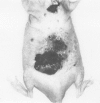Abstract
Skh/hr-1 hairless albino mice were irradiated with photocarcinogenic dosages of ultraviolet light for periods of 30 weeks or longer. A high proportion of mice developed pleomorphic spindle cell tumors and epidermal neoplasms of various types. These spindle cell tumors were studied by immunofluorescence and immunoperoxidase techniques and by electron microscopy. Freshly isolated tumor cells were grown in tissue culture. Immunocytochemical analysis showed varying expression of markers of mesenchymal differentiation: vimentin, procollagens I and III, type I collagen, and lysozyme. Electron microscopy showed spindled and cuboidal cells with abundant endoplasmic reticulum, filopodia, and lysosomes, but no intercellular connections. The cells grown in vitro were cuboidal and stellate and also showed mesenchymal differentiation by electron microscopy. These results are perhaps similar to those described for a human actinically produced fibrohistiocytic neoplasm, atypical fibroxanthoma, and this system may provide a useful model of ultraviolet-induced dermal neoplasia.
Full text
PDF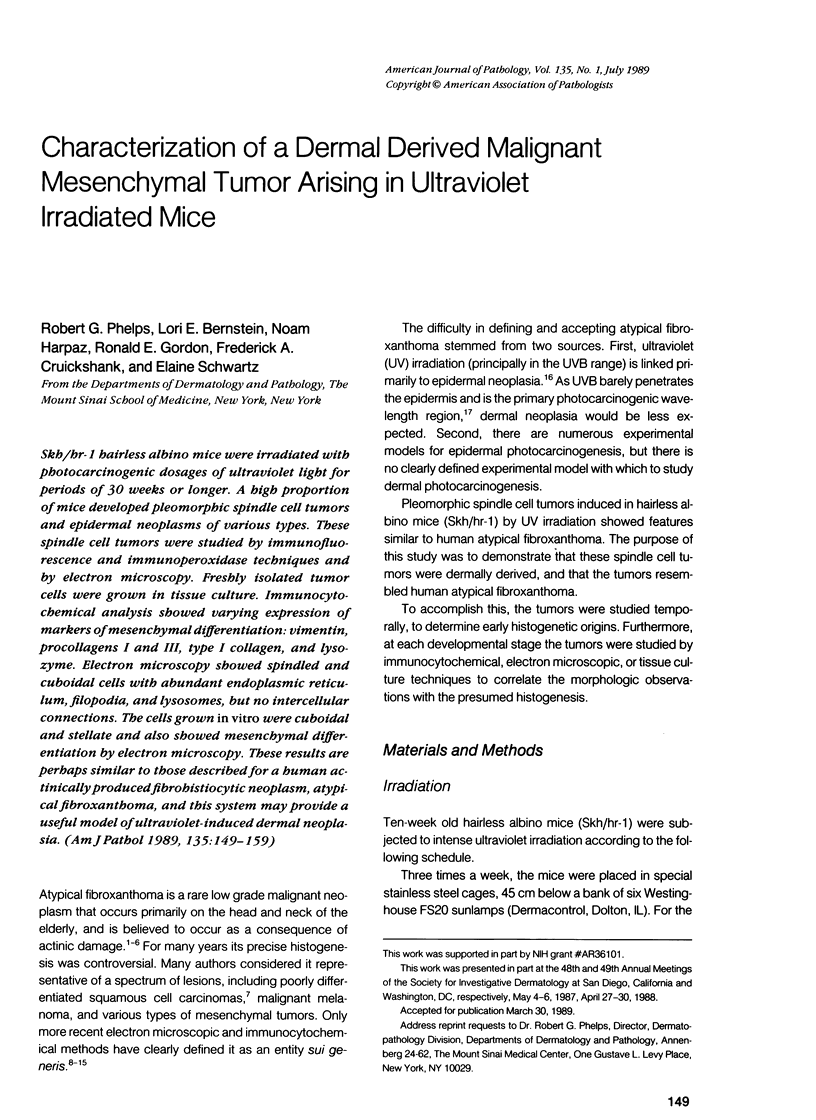
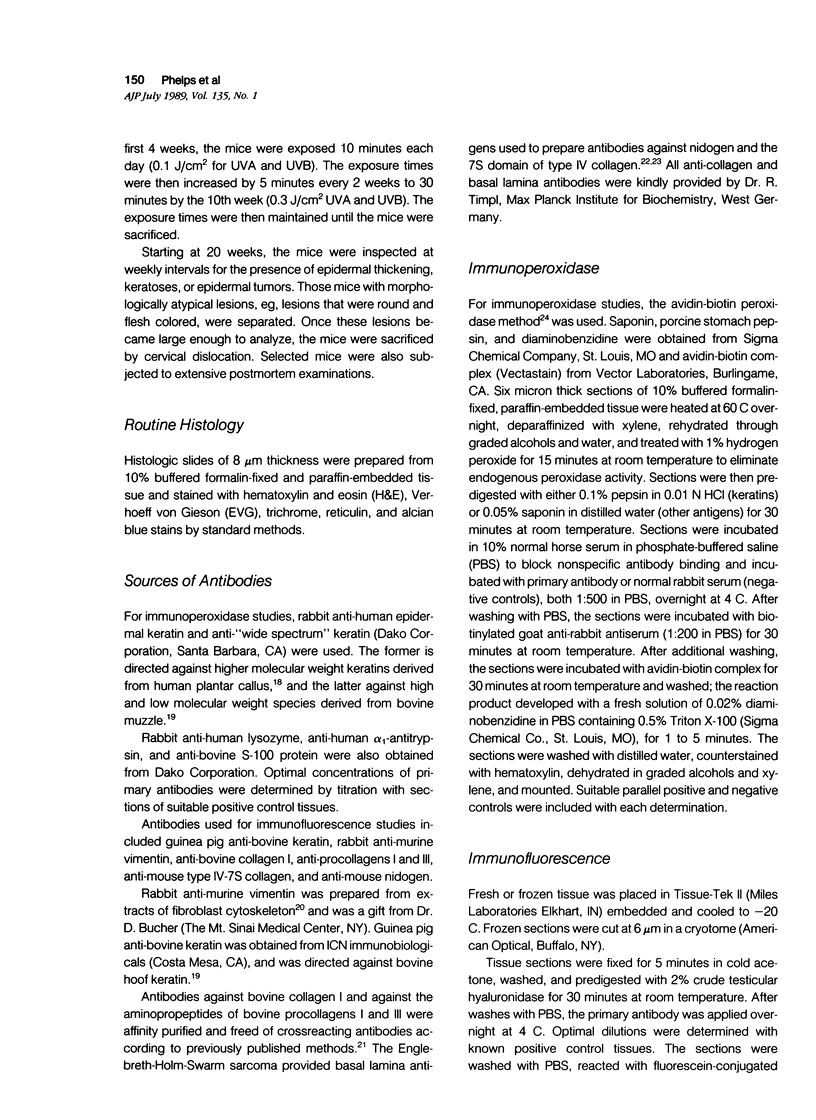
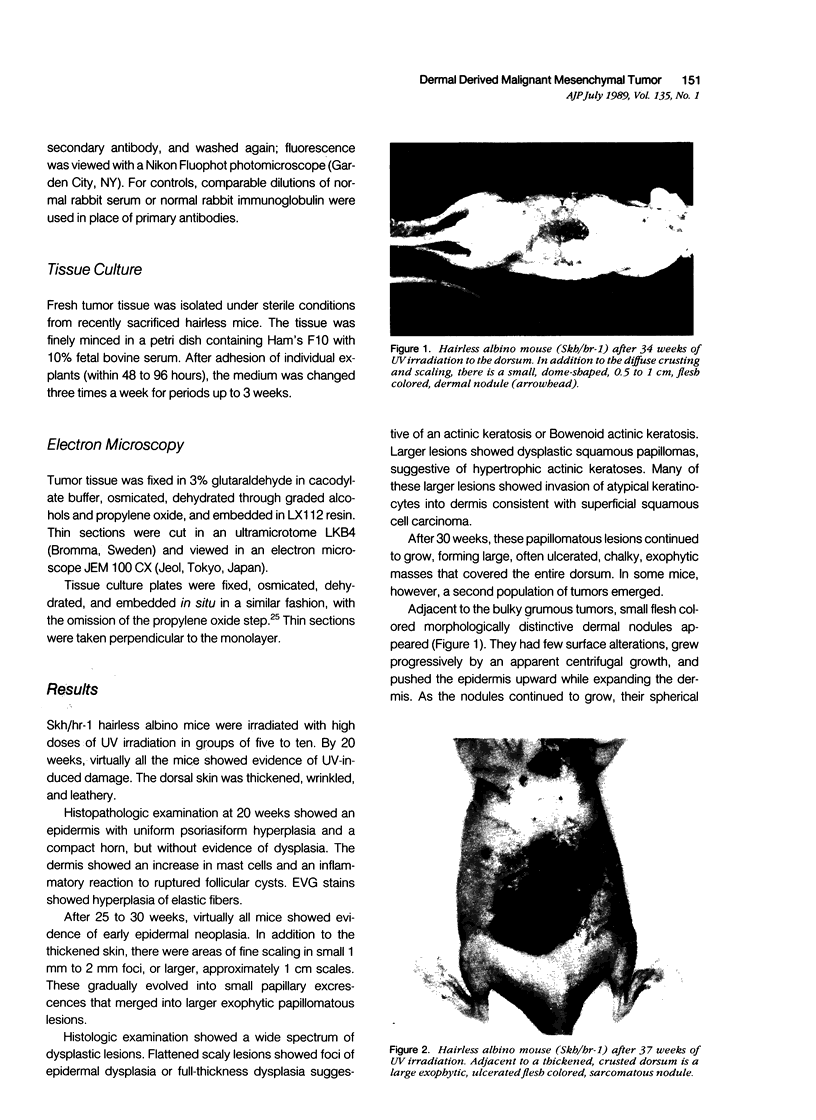
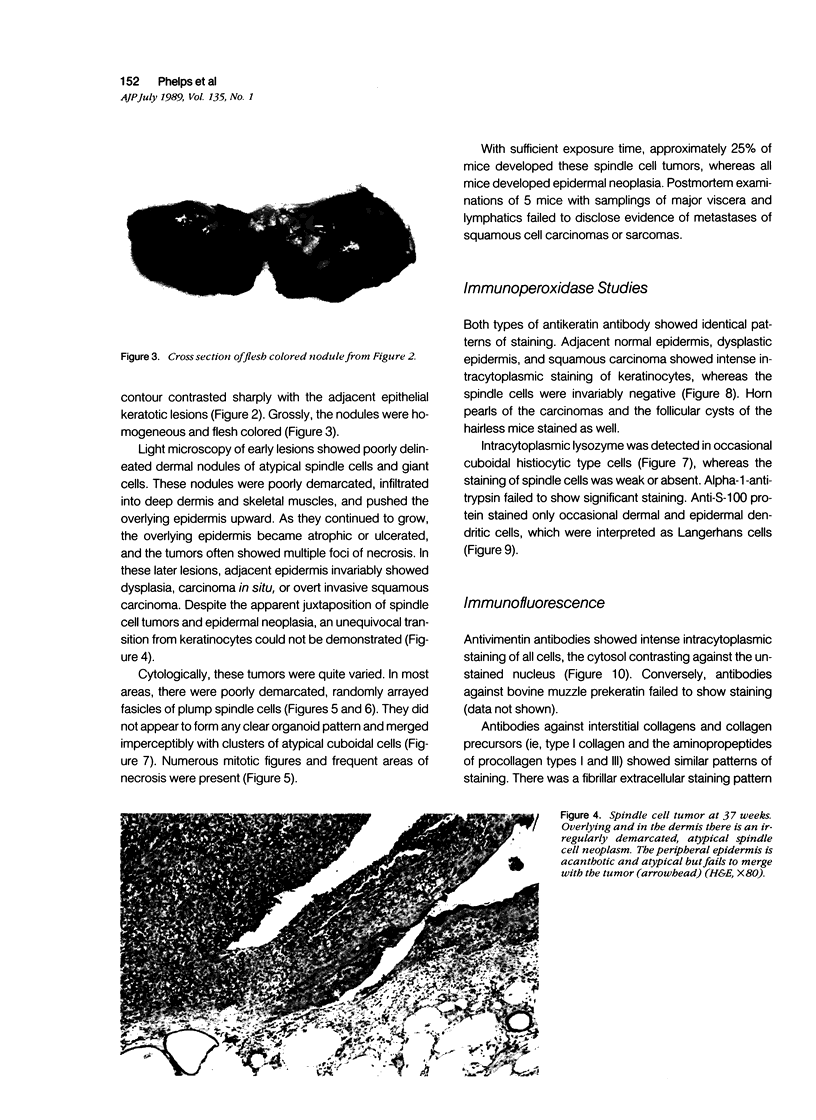
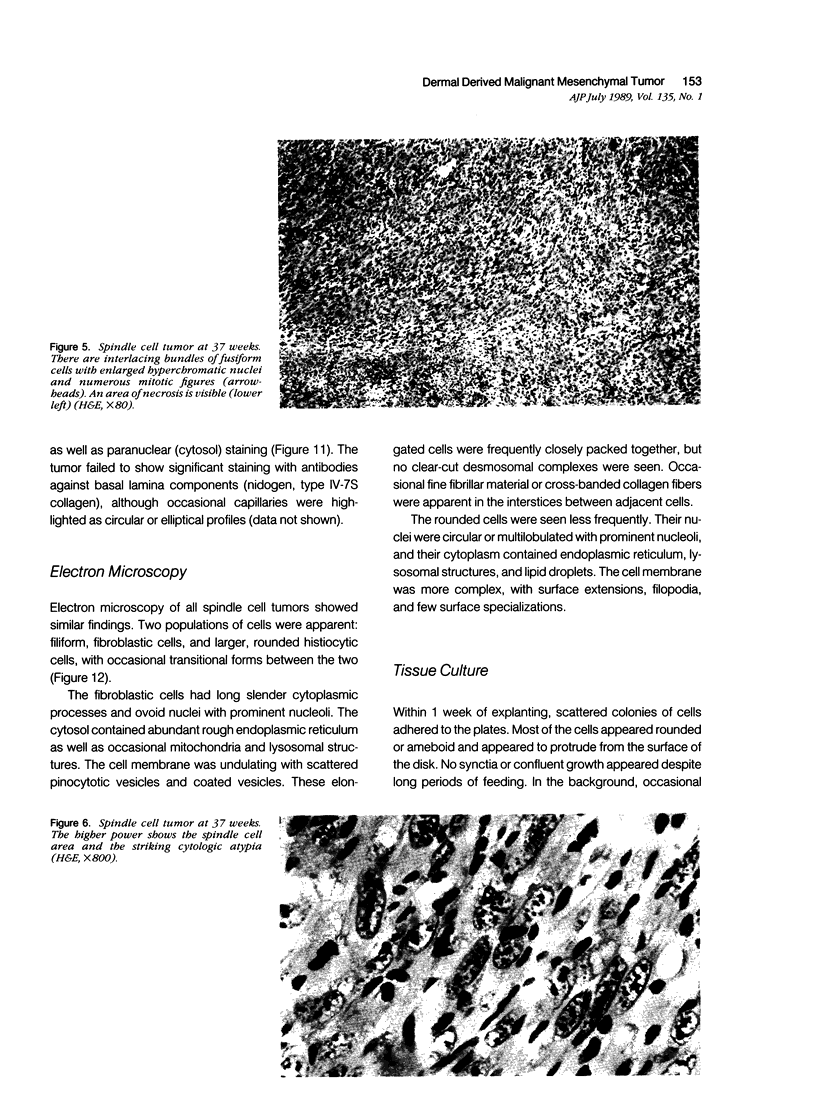
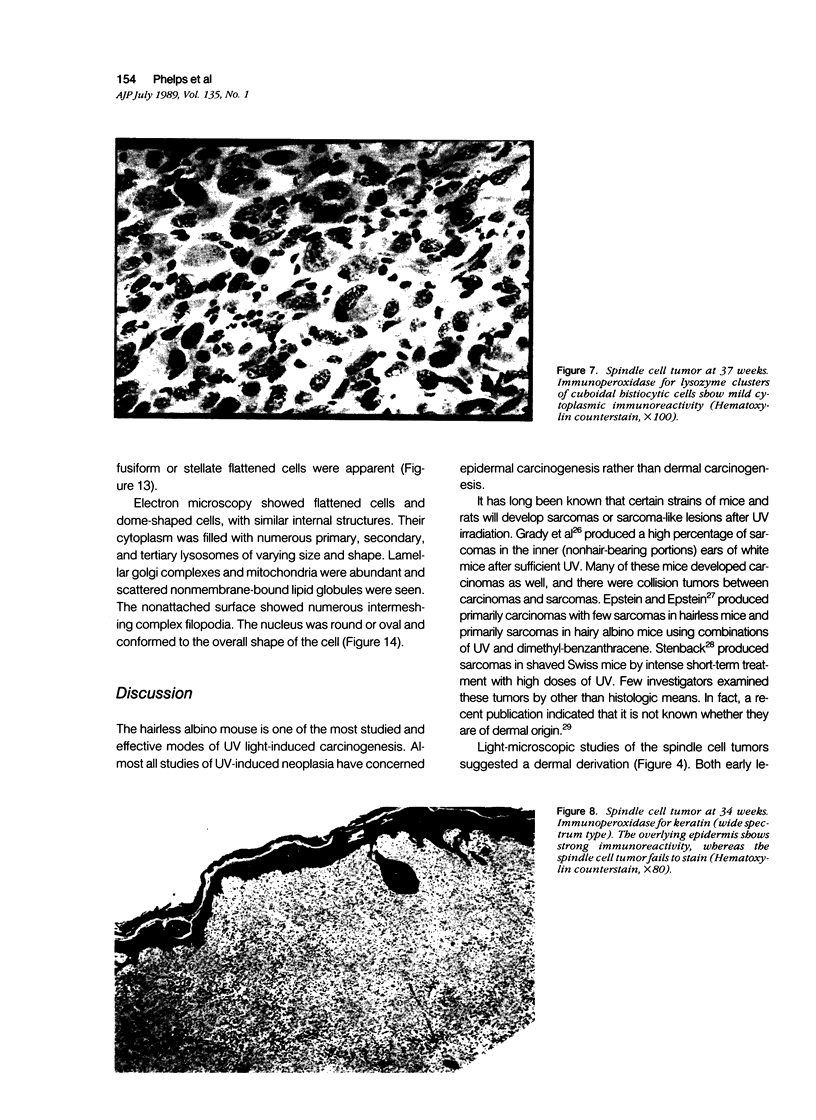
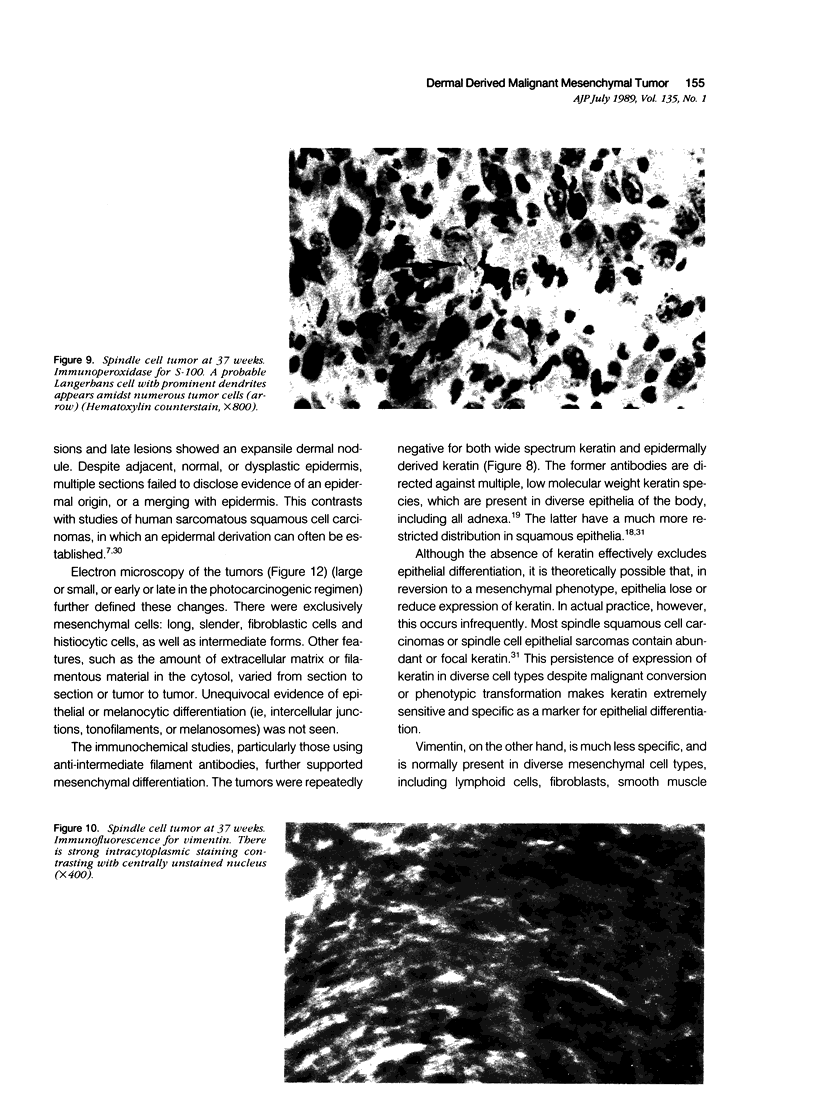
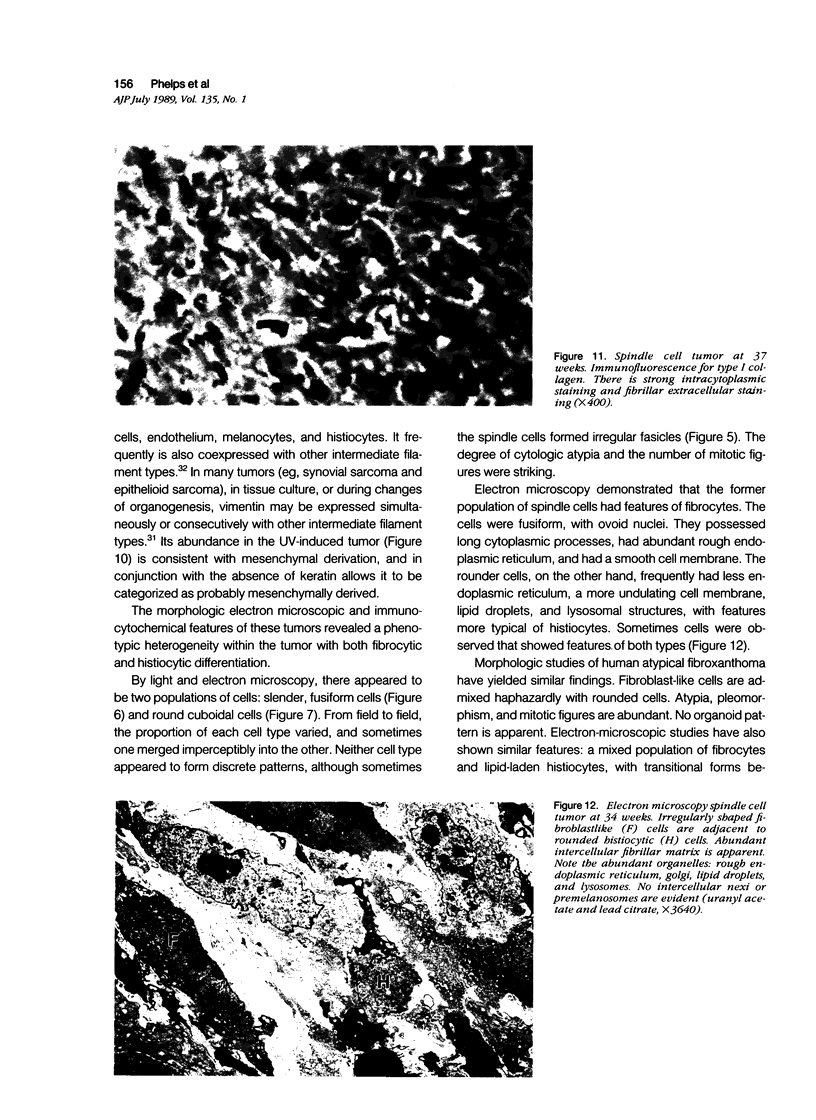
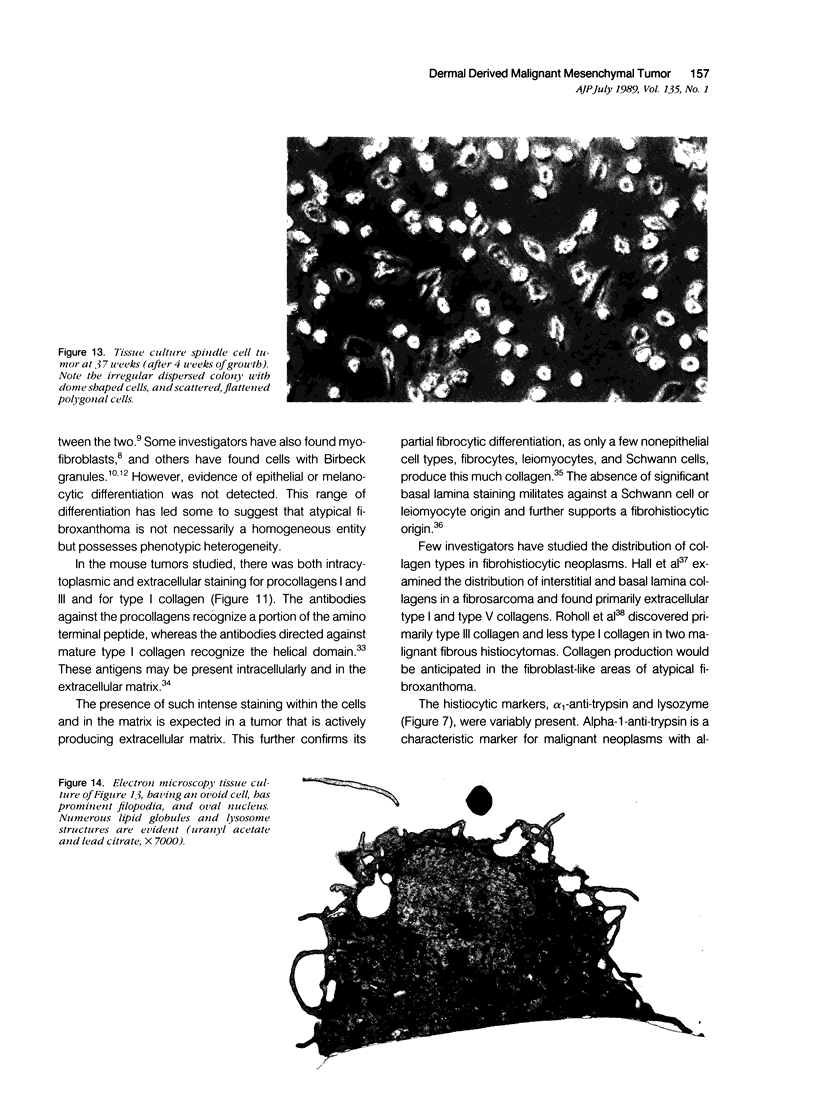
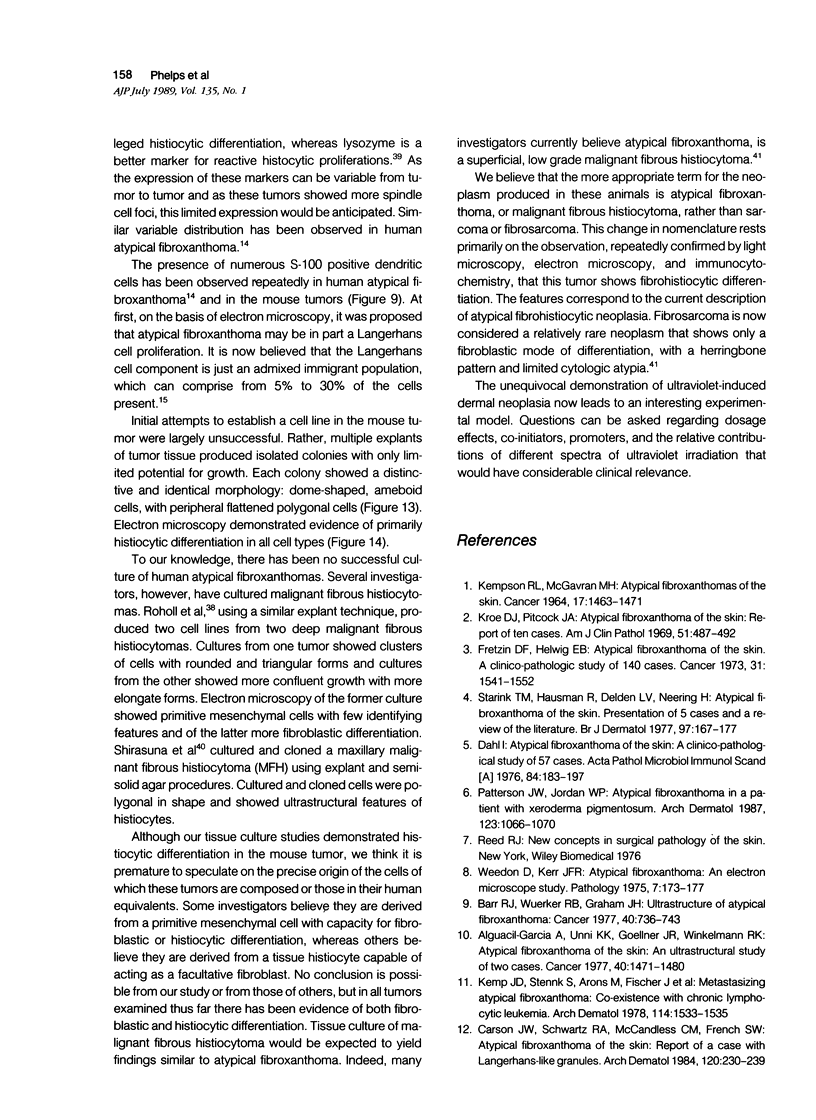
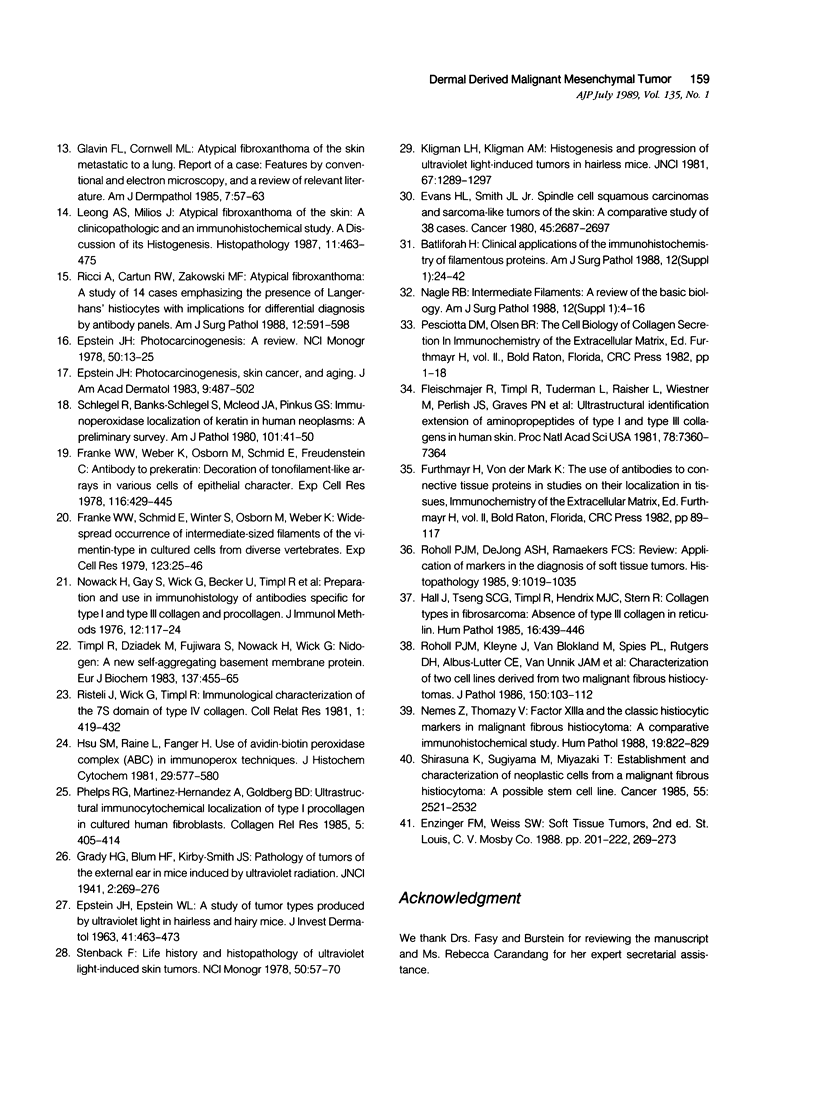
Images in this article
Selected References
These references are in PubMed. This may not be the complete list of references from this article.
- Alguacil-Garcia A., Unni K. K., Goellner J. R., Winkelmann R. K. Atypical fibroxanthoma of the skin: an ultrastructural study of two cases. Cancer. 1977 Oct;40(4):1471–1480. doi: 10.1002/1097-0142(197710)40:4<1471::aid-cncr2820400418>3.0.co;2-c. [DOI] [PubMed] [Google Scholar]
- Barr R. J., Wuerker R. B., Graham J. H. Ultrastructure of atypical fibroxanthoma. Cancer. 1977 Aug;40(2):736–743. doi: 10.1002/1097-0142(197708)40:2<736::aid-cncr2820400222>3.0.co;2-p. [DOI] [PubMed] [Google Scholar]
- Battifora H. Clinical applications of the immunohistochemistry of filamentous proteins. Am J Surg Pathol. 1988;12 (Suppl 1):24–42. [PubMed] [Google Scholar]
- Carson J. W., Schwartz R. A., McCandless C. M., Jr, French S. W. Atypical fibroxanthoma of the skin. Report of a case with Langerhans-like granules. Arch Dermatol. 1984 Feb;120(2):234–239. [PubMed] [Google Scholar]
- Dahl I. Atypical fibroxanthoma of the skin. A clinico-pathological study of 57 cases. Acta Pathol Microbiol Scand A. 1976 Mar;84(2):183–197. [PubMed] [Google Scholar]
- EPSTEIN J. H., EPSTEIN W. L. A STUDY OF TUMOR TYPES PRODUCED BY ULTRAVIOLET LIGHT IN HAIRLESS AND HAIRY MICE. J Invest Dermatol. 1963 Dec;41:463–473. doi: 10.1038/jid.1963.142. [DOI] [PubMed] [Google Scholar]
- Epstein J. H. Photocarcinogenesis, skin cancer, and aging. J Am Acad Dermatol. 1983 Oct;9(4):487–502. doi: 10.1016/s0190-9622(83)70160-x. [DOI] [PubMed] [Google Scholar]
- Epstein J. H. Photocarcinogenesis: a review. Natl Cancer Inst Monogr. 1978 Dec;(50):13–25. [PubMed] [Google Scholar]
- Evans H. L., Smith J. L. Spindle cell squamous carcinomas and sarcoma-like tumors of the skin: a comparative study of 38 cases. Cancer. 1980 May 15;45(10):2687–2697. doi: 10.1002/1097-0142(19800515)45:10<2687::aid-cncr2820451034>3.0.co;2-r. [DOI] [PubMed] [Google Scholar]
- Fleischmajer R., Timpl R., Tuderman L., Raisher L., Wiestner M., Perlish J. S., Graves P. N. Ultrastructural identification of extension aminopropeptides of type I and III collagens in human skin. Proc Natl Acad Sci U S A. 1981 Dec;78(12):7360–7364. doi: 10.1073/pnas.78.12.7360. [DOI] [PMC free article] [PubMed] [Google Scholar]
- Franke W. W., Schmid E., Winter S., Osborn M., Weber K. Widespread occurrence of intermediate-sized filaments of the vimentin-type in cultured cells from diverse vertebrates. Exp Cell Res. 1979 Oct 1;123(1):25–46. doi: 10.1016/0014-4827(79)90418-x. [DOI] [PubMed] [Google Scholar]
- Franke W. W., Weber K., Osborn M., Schmid E., Freudenstein C. Antibody to prekeratin. Decoration of tonofilament like arrays in various cells of epithelial character. Exp Cell Res. 1978 Oct 15;116(2):429–445. doi: 10.1016/0014-4827(78)90466-4. [DOI] [PubMed] [Google Scholar]
- Fretzin D. F., Helwig E. B. Atypical fibroxanthoma of the skin. A clinicopathologic study of 140 cases. Cancer. 1973 Jun;31(6):1541–1552. doi: 10.1002/1097-0142(197306)31:6<1541::aid-cncr2820310635>3.0.co;2-6. [DOI] [PubMed] [Google Scholar]
- Glavin F. L., Cornwell M. L. Atypical fibroxanthoma of the skin metastatic to a lung. Report of a case, features by conventional and electron microscopy, and a review of relevant literature. Am J Dermatopathol. 1985 Feb;7(1):57–63. doi: 10.1097/00000372-198502000-00013. [DOI] [PubMed] [Google Scholar]
- Hall J., Tseng S. C., Timpl R., Hendrix M. J., Stern R. Collagen types in fibrosarcoma: absence of type III collagen in reticulin. Hum Pathol. 1985 May;16(5):439–446. doi: 10.1016/s0046-8177(85)80080-0. [DOI] [PubMed] [Google Scholar]
- Hsu S. M., Raine L., Fanger H. Use of avidin-biotin-peroxidase complex (ABC) in immunoperoxidase techniques: a comparison between ABC and unlabeled antibody (PAP) procedures. J Histochem Cytochem. 1981 Apr;29(4):577–580. doi: 10.1177/29.4.6166661. [DOI] [PubMed] [Google Scholar]
- KEMPSON R. L., MCGAVRAN M. H. ATYPICAL FIBROXANTHOMAS OF THE SKIN. Cancer. 1964 Nov;17:1463–1471. doi: 10.1002/1097-0142(196411)17:11<1463::aid-cncr2820171114>3.0.co;2-e. [DOI] [PubMed] [Google Scholar]
- Kemp J. D., Stenn K. S., Arons M., Fischer J. Metastasizing atypical fibroxanthoma. Coexistence with chronic lymphocytic leukemia. Arch Dermatol. 1978 Oct;114(10):1533–1535. doi: 10.1001/archderm.114.10.1533. [DOI] [PubMed] [Google Scholar]
- Kligman L. H., Kligman A. M. Histogenesis and progression in ultraviolet light-induced tumors in hairless mice. J Natl Cancer Inst. 1981 Dec;67(6):1289–1293. [PubMed] [Google Scholar]
- Kroe D. J., Pitcock J. A. Atypical fibroxanthoma of the skin. Report of ten cases. Am J Clin Pathol. 1969 Apr;51(4):487–492. doi: 10.1093/ajcp/51.4.487. [DOI] [PubMed] [Google Scholar]
- Leong A. S., Milios J. Atypical fibroxanthoma of the skin: a clinicopathological and immunohistochemical study and a discussion of its histogenesis. Histopathology. 1987 May;11(5):463–475. doi: 10.1111/j.1365-2559.1987.tb02655.x. [DOI] [PubMed] [Google Scholar]
- Nagle R. B. Intermediate filaments: a review of the basic biology. Am J Surg Pathol. 1988;12 (Suppl 1):4–16. [PubMed] [Google Scholar]
- Nemes Z., Thomázy V. Factor XIIIa and the classic histiocytic markers in malignant fibrous histiocytoma: a comparative immunohistochemical study. Hum Pathol. 1988 Jul;19(7):822–829. doi: 10.1016/s0046-8177(88)80266-1. [DOI] [PubMed] [Google Scholar]
- Nowack H., Gay S., Wick G., Becker U., Timpl R. Preparation and use in immunohistology of antibodies specific for type I and type III collagen and procollagen. J Immunol Methods. 1976;12(1-2):117–124. doi: 10.1016/0022-1759(76)90101-0. [DOI] [PubMed] [Google Scholar]
- Patterson J. W., Jordan W. P., Jr Atypical fibroxanthoma in a patient with xeroderma pigmentosum. Arch Dermatol. 1987 Aug;123(8):1066–1070. [PubMed] [Google Scholar]
- Phelps R. G., Martinez-Hernandez A., Goldberg B. D. Ultrastructural immunocytochemical localization of type I procollagen in cultured human fibroblasts. Coll Relat Res. 1985 Nov;5(5):405–414. doi: 10.1016/s0174-173x(85)80028-5. [DOI] [PubMed] [Google Scholar]
- Ricci A., Jr, Cartun R. W., Zakowski M. F. Atypical fibroxanthoma. A study of 14 cases emphasizing the presence of Langerhans' histiocytes with implications for differential diagnosis by antibody panels. Am J Surg Pathol. 1988 Aug;12(8):591–598. [PubMed] [Google Scholar]
- Risteli J., Wick G., Timpl R. Immunological characterization of the 7-S domain of type IV collagens. Coll Relat Res. 1981 Sep;1(5):419–432. doi: 10.1016/s0174-173x(81)80026-x. [DOI] [PubMed] [Google Scholar]
- Roholl P. J., De Jong A. S., Ramaekers F. C. Application of markers in the diagnosis of soft tissue tumours. Histopathology. 1985 Oct;9(10):1019–1035. doi: 10.1111/j.1365-2559.1985.tb02782.x. [DOI] [PubMed] [Google Scholar]
- Roholl P. J., Kleyne J., Van Blokland M., Spies P. L., Rutgers D. H., Albus-Lutter C. E., Van Unnik J. A. Characterization of two cell lines, derived from two malignant fibrous histiocytomas. J Pathol. 1986 Oct;150(2):103–112. doi: 10.1002/path.1711500204. [DOI] [PubMed] [Google Scholar]
- Schlegel R., Banks-Schlegel S., McLeod J. A., Pinkus G. S. Immunoperoxidase localization of keratin in human neoplasms: a preliminary survey. Am J Pathol. 1980 Oct;101(1):41–49. [PMC free article] [PubMed] [Google Scholar]
- Shirasuna K., Sugiyama M., Miyazaki T. Establishment and characterization of neoplastic cells from a malignant fibrous histiocytoma. A possible stem cell line. Cancer. 1985 Jun 1;55(11):2521–2532. doi: 10.1002/1097-0142(19850601)55:11<2521::aid-cncr2820551102>3.0.co;2-l. [DOI] [PubMed] [Google Scholar]
- Starink T. H., Hausman R., Van Delden L., Neering H. Atypical fibroxanthoma of the skin. Presentation of 5 cases and a review of the literature. Br J Dermatol. 1977 Aug;97(2):167–177. doi: 10.1111/j.1365-2133.1977.tb15062.x. [DOI] [PubMed] [Google Scholar]
- Stenbäck F. Life history and histopathology of ultraviolet light-induced skin tumors. Natl Cancer Inst Monogr. 1978 Dec;(50):57–70. [PubMed] [Google Scholar]
- Timpl R., Dziadek M., Fujiwara S., Nowack H., Wick G. Nidogen: a new, self-aggregating basement membrane protein. Eur J Biochem. 1983 Dec 15;137(3):455–465. doi: 10.1111/j.1432-1033.1983.tb07849.x. [DOI] [PubMed] [Google Scholar]
- Weedon D., Kerr J. F. Atypical fibroxanthoma of skin: an electron microscope study. Pathology. 1975 Jul;7(3):173–177. doi: 10.3109/00313027509094404. [DOI] [PubMed] [Google Scholar]




